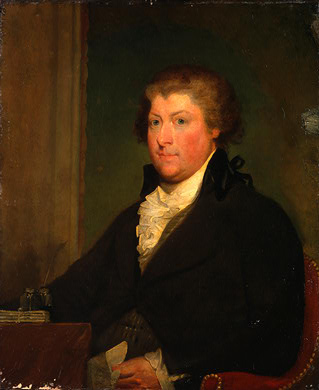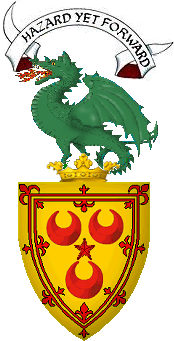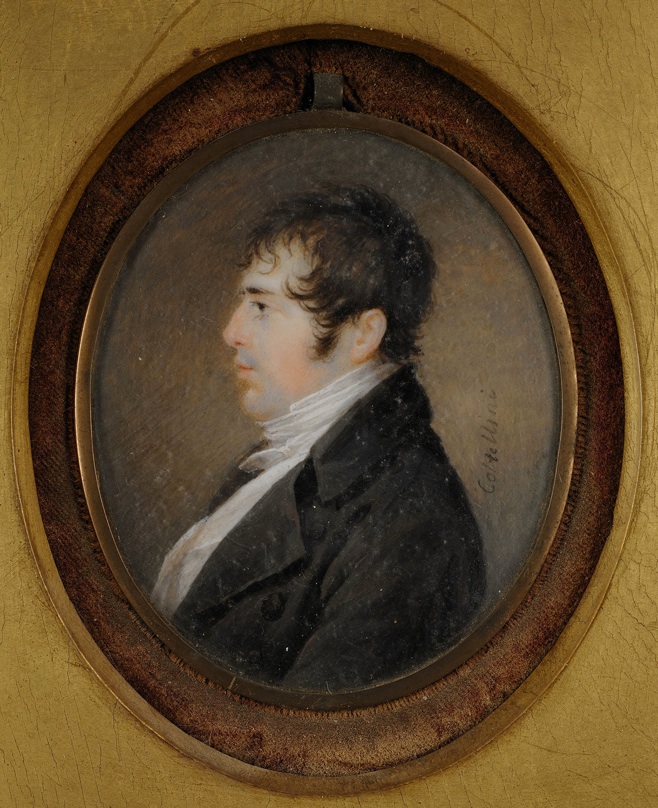|

William Seton,
Esq., Rep. of Parbroath, of New York
William Seton was born
24th April 1746 at his mothers family's home of Hillside,
Edinburgh, while on a trip to visit her family and designed to
ensure that her son would be born in Scotland. He recieved a
good education and was well traveled, speaking English, French and
Spanish fluently, and was sent to study for a time in San Lucar,
Spain.
He was the 2nd son and
heir of London businessman John Seton and his cousin Elizabeth
Seton (of the family of John Seton, Town Clerk of Burntisland,
Fife, in the early 18th century, and who's son James Seton
acquired the lands of Belshes, Haddington between 1715-1721 and
who's son, also James Seton of Hillside was for many years,
Director of the Bank of Scotland and who when he sold the estate
of Belshes, he allotted to his sister Elizabeth her portion of the
sale, which was at that time a considerable sum, 1600 Pounds).
William's older brother John Seton emigrated and died unmarried in
the British West Indies and was buried "within the parish of St.
James', Barbados, Dec 22nd, 1768", and William then became heir of
the Seton's of Parbroath.
William's sisters Isabella, Jane,
Elizabeth, all married Gentry: Isabella married Sir Thomas Cayley,
Bart., of Yorkshire; Jane married Sir Walter Synnot, Knt, of
Ballymoyer House, County Armagh, Ireland in 1770 and founded the
Seton-Synnots; Elizabeth married Robert Berry, Esq., of Kirkbridge
House, Yorkshire, nephew of Fergusson of Raith, Fife.
Williams two other sisters Margaret and Barbara were married into
branches of the Setons: Margaret married Andrew Seton, Esq.,
of the family of Barnes who settled for a time in New York, but
later went to Florida after the Revolutionary War and had issue;
and Barbara who married George Seton, Esq., of the Seton's of
Abercorn and brother to Captain Sir Henry John Seton, Bart, and
had an only daughter, Barbara Seton, "Bab".
William emigrated to New York
in 1763, at the instigation of his brother-in-law Andrew Seton of
the Barnes Family, and became superintendent and part owner of the
iron-works of Ringwood, N.J. as well as owner of various lands in
the interior of New York around 1766, which lands were referred to
as the Mohawk Lands. In 1765, he was elected an
officer of the Saint Andrew's Society, and became a member of the
New York Chamber of Commerce in 1768, the year of it's foundation.
In 1786, he was further elected as one of the founding members of
the Saint George's Society of New York as well.
It was in New York that William began to
establish his fortunes and was an active merchant in importing
goods from Europe and India, with his place of business at what
was then known as Cruger's Dock. He also acquired a
considerable property in Halifax, Nova Scotia, called in his old
family papers as the Halifax Estate, which later became
very valuable, being estimated at approx. 600, 000 Pounds circa
1890, and on which property now stands the Government Buildings of
Nova Scotia in downtown Halifax. The property in Halifax was
lost during the Revolutionary War, through both mismanagement and
fraud, and as the English authorities condemned Seton for his
remaining in New York and not leaving with the Loyalists.
There were various attempts made to regain possession of the
Estate, but all of which were denied or were simply unsuccessful.
William was a
Loyalist, and the last Royal
Public Notary for the city and province of New York during the
War. His silver notarial seal, dated 1779, is still in the
possession of his family. At the beginning of the 'troubles'
in America, he was a member of the Committee of One Hundred
elected May 1, 1775, to control the affairs of the city and county
of New York. Despite the Revolution, he was strongly
attached by education, friendships and family to the cause of his
Mother Country in her dispute with the Colonies, but remained
diplomatic in his stance between the two. Although he lost
some property during the events of the War, he was in no way
molested by the American troops, and became a citizen of the
Republic and was held in high esteem by all. He continued to
work at international connections, which were of great benefit to
the new country, in particular that of the French Government, and
was considered as a candidate for the Presidency for the new
Republic.
Though
financially ruined at the close of the Revolution, he founded the
once famous mercantile house of Seton, Maitland & Co., and was
similarly the first Cashier and Officer of the Bank of New York
for which he was nominated to become the first President, though
he declined out of 'political consideration'. His
enterprising nature, however, soon restored his fortunes, and he
was noted as a considerate and generous man, hospitable and
keeping an exemplary house at his residence at Hanover Square, and
much given to entertaining. In addition to his residence in the city, he
acquired, in 1784, the property which at that time was a country
place several miles from the heart of New York, in Bloomingdale,
on the west-side of the island of Manhattan about where 78th St.
is now, and called this place or estate, Craigdon (Cragdon or
Craggdon), as a country retreat, and which is preserved now as a
Public Park, called Seton Falls.
William Seton was twice married, 1st, on the
2nd of March, 1767, to Rebecca Curzon, eldest daughter of Richard
Curzon of the family of John Curzon of Waterperry, Oxfordshire, of
the Curzon Baronets (by which his son became heir-of-line), and
had four son's and one daughter:
William 'Magee' Seton, his heir who married
Elizabeth Ann Bayley and had 5 children: two sons, William Seton his
heir and Richard Bayley Seton who dsp while traveling to Africa; and three
daughters, Anna Maria who died young, Rebecca who died a nun, and
Catherine who also became a nun, and became Mother Catherine Seton
and died in old age sp.
James Seton, an Lieutenant in the
74th Highland Regiment in Halifax, later a Major in the American
New York Militia in the failed War of 1812 with Canada. He
married Mary Gillon Hoffman of New York and had a son and heir,
Alfred Seton who had issue, and four daughters.
John Seton, who married a Miss Wise
of the family from Alexandria, Virginia and had two daughters.
Henry Seton, a Lieutenant in the US
Navy, dsp.
Anna Maria, who married the Hon. US
Senator John Middleton Vining, of Delaware and had two sons.
William married, 2nd, his wife's sister, Anna
Maria Curzon, on the 29th of November, 1776, at Brunswick, New
Jersey in the Presbyterian Church there. By his second
marriage William Seton had 2 sons and 6 daughter's:
-
Samuel Waddington Seton,
highly educated, traveled to China and was married at the death
bed of a clergyman, Superintendent of the Public Schools of New
York, dsp.
-
Edward Augustus Seton, who
settled in the Louisiana Territory and married late in life and
had 1 son who was a Lieutenant in the Confederate Army, and who
was killed in a battle before Richmond, Virginia in 1862, sp.
-
Charlotte, married Gouverneur
Ogden, Esq. who was a partner of Alexander Hamilton and who
founded Ogdensburg, N.Y.
-
Elizabeth, married James
Maitland, Esq. of the noted Scottish family.
-
Mary, died young unmarried,
sp.
-
Rebecca, died young unmarried,
sp.
-
Henrietta, known as Harriet,
died young unmarried, sp.
-
Cecilia, the youngest child,
died young unmarried, sp.
All of the Seton's of Parbroath of New York
were distinguished as being tall, and of "good looks", for their
love of learning which was hereditary of the Seton's, and for
their strong family attachment. William Seton himself was
noted as a large and handsome man, of dignified presence and
benevolent features and extremely neat in his personal appearance.
His family portrait, painted shorty before his death, was done by
the American artist, Gilbert Stuart. He suffered intensely
from pain in his final year, resulting from injuries sustained
from an accidental fall at the entrance to his home on the 25th of
January 1798, died prematurely in his 52nd year, on the 9th of
June, 1798 and was buried in Trinity Churchyard, where it was
written at his death:
"Perhaps there never was an
instance of any person being so universally loved and lamented,
Nearly 500 people attended him to the grave, chiefly dressed in
black, with every mark of unaffected sorrow...".
William's oldest
son and heir, William Seton (commonly called William Magee
Seton), was born at sea on his parents return to America from
a visit to England, aboard the ship Edward, on the 20th of
April, 1768. One of his sponsors at Baptism in the
Protestant Episcopalian Church on the 8th of May, 1768, was the
wealthy merchant William Magee of London, and for which William
later assumed his godfather's surname as a middle-name upon
receiving an inheritance from him. William was himself
educated in England at the age of 10 years, at the private College
of Richmond near London. He left his studies at sixteen and
traveled for several years throughout Europe and was given to
Poetry and Music, and was noted as a skilful player of the violin
and was the only owner of a genuine Stradivarius in New
York at that time and which passed to Richard Seton.
Portrait below of Richard Bayley Seton (1798-1823). His oval
profile portrait, watercolor on ivory, of Richard Bayley Seton,
signed vertically right hand side behind subject's shoulder "Coltellini"
(Constantina Coltellini, Naples, Italy, active circa 1819).
Portrait measures 2 3/4" H x 2 1/4" W. Overall – 9 1/4" H x 8
3/4" W. Richard Bayley Seton (1798-1823) was the son of William
Magee Seton and Elizabeth Ann Bayley Seton, the first
American-born Roman Catholic Saint. Richard joined the US Navy
in 1822, was assigned to the USS Oswego, and died at sea off the
coast of Liberia the following year at the age of 23.
 William Magee Seton married Elizabeth Ann Bayley in 1793,
and she was later to become the first American Catholic Saint, St.
Elizabeth Ann Seton.
William and Elizabeth had five children, two sons and three
daughters, though after the death of his father, William Seton Sr in 1798, they
assumed care for William's seven siblings and he assumed
control of the family Seton shipping business. However, due to his
own ill-health he poorly managed the business and it failed. In 1803,
due to a developing tuberculosis, he and Elizabeth went on a
voyage to Pisa, Italy
in which he had hoped that the mild and beneficial air would have
been been a remedy for his condition. However, he was placed
in quarantine by the Italian Government for almost a month.
In Italy, they became acquainted there with the Catholic Chevalier
Philip Filicchi and his family, although William died after his
release two weeks later from quarantine at
the Filicchi home in Pisa on Dec. 27th, 1803, and was buried in
the Cemetery at Leghorn in a modest tomb next to Smollett's. William Magee Seton married Elizabeth Ann Bayley in 1793,
and she was later to become the first American Catholic Saint, St.
Elizabeth Ann Seton.
William and Elizabeth had five children, two sons and three
daughters, though after the death of his father, William Seton Sr in 1798, they
assumed care for William's seven siblings and he assumed
control of the family Seton shipping business. However, due to his
own ill-health he poorly managed the business and it failed. In 1803,
due to a developing tuberculosis, he and Elizabeth went on a
voyage to Pisa, Italy
in which he had hoped that the mild and beneficial air would have
been been a remedy for his condition. However, he was placed
in quarantine by the Italian Government for almost a month.
In Italy, they became acquainted there with the Catholic Chevalier
Philip Filicchi and his family, although William died after his
release two weeks later from quarantine at
the Filicchi home in Pisa on Dec. 27th, 1803, and was buried in
the Cemetery at Leghorn in a modest tomb next to Smollett's.
William
Magee Seton and
Elizabeth's oldest son, William Seton III, was a Lieutenant in the
United States Navy and traveled heavily. He was recognized by Burke's "Peerage " as the
head of the ancient family of the Setons of Parbroath, senior
cadets of the Earls of Winton in Scotland. He married Emily
Prime, July 17th, 1832 and had nine children, two if which died
young (George died in infancy). Of their children:
-
William Seton,
born the 28th of January, 1835, he educated at the Jesuits College
of Fordham and later at Mount St. Mary's, Emmittsburg, Maryland
with private tutors. He was a Latin scholar and studied Law,
as well as French and German. During the US Civil War he
became a Captain in the 4th New York Regiment (where he was twice
severely wounded at Antietam and acquitted himself with great
gallantry) and later a Captain in the 16th Artillery. After
the Civil War he devoted himself to literary pursuits and married
Sarah Redwood Parrish on January 3rd, 1884. They had an only
son, William, who died in infancy. He was a frequent
contributor to periodicals and journals, and published "Romance of
the Charter Oak" "The Pride of Lexington; a Tale of the American
Revolution " ; and other works.
-
Henry Seton, a
Lieutenant in the 26th Rifle Battalion under the Duke of
Wurtemberg of Austria, and later Captiand and 2nd Lieutenant in
the American Army. He married Ann Foster, daughter of
Major-General John Gray Foster, April 27th 1870 and had two sons:
John Seton, who after studying and Mount St. Mary's College and
visiting Europe twice, died unmarried sp., in Emmittsburg; and
William Seton, a graduate of Seton Hall College who was a doctor
of Medicine.
-
Robert Seton,
born August 28th, 1839, was educated at Mount St. Mary's College
and studied Theology and Canon Law in Rome. After
being named a Protho-notary Apostolic, was Rector of of Saint
Joseph's Church in New Jersey. He later took his Degree of
Doctor of Divinity at the Roman University of the Sapienza
and was a trustee of Seton Hall College. He was highly
published, and his History of the Seton's of Scotland and America
is one of the cherished histories of the House of Seton. He
became Archbishop Robert Seton of New York, and dsp.
-
Emily, educated
at Sacre Coeur in Paris, died young, unmarried, sp.
-
Elizabeth,
educated at Sacre Coeur in Paris, a writer.
-
Helen, educated
at Sacre Coeur in Paris, a nun in the Order of Mercy, died
unmarried, sp.
-
Isabella,
educated at Sacre Coeur in Paris, and at the Trinita dei Monti in
Rome, married Thomas Jevons, Esq., April 19th, 1870, and had four
children, Reginald Jevons, Thomas Seton-Jevons, Ferdinand Talbot
Roscoe Jevons and Marguerite Jevons.
|

